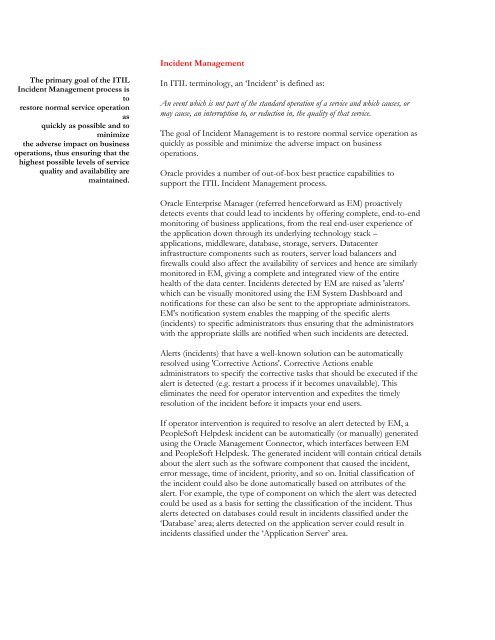ITIL Best Practices with Oracle Enterprise Manager 10g and Oracle ...
ITIL Best Practices with Oracle Enterprise Manager 10g and Oracle ...
ITIL Best Practices with Oracle Enterprise Manager 10g and Oracle ...
Create successful ePaper yourself
Turn your PDF publications into a flip-book with our unique Google optimized e-Paper software.
Incident Management<br />
The primary goal of the <strong>ITIL</strong><br />
Incident Management process is<br />
to<br />
restore normal service operation<br />
as<br />
quickly as possible <strong>and</strong> to<br />
minimize<br />
the adverse impact on business<br />
operations, thus ensuring that the<br />
highest possible levels of service<br />
quality <strong>and</strong> availability are<br />
maintained.<br />
In <strong>ITIL</strong> terminology, an ‘Incident’ is defined as:<br />
An event which is not part of the st<strong>and</strong>ard operation of a service <strong>and</strong> which causes, or<br />
may cause, an interruption to, or reduction in, the quality of that service.<br />
The goal of Incident Management is to restore normal service operation as<br />
quickly as possible <strong>and</strong> minimize the adverse impact on business<br />
operations.<br />
<strong>Oracle</strong> provides a number of out-of-box best practice capabilities to<br />
support the <strong>ITIL</strong> Incident Management process.<br />
<strong>Oracle</strong> <strong>Enterprise</strong> <strong>Manager</strong> (referred henceforward as EM) proactively<br />
detects events that could lead to incidents by offering complete, end-to-end<br />
monitoring of business applications, from the real end-user experience of<br />
the application down through its underlying technology stack –<br />
applications, middleware, database, storage, servers. Datacenter<br />
infrastructure components such as routers, server load balancers <strong>and</strong><br />
firewalls could also affect the availability of services <strong>and</strong> hence are similarly<br />
monitored in EM, giving a complete <strong>and</strong> integrated view of the entire<br />
health of the data center. Incidents detected by EM are raised as 'alerts'<br />
which can be visually monitored using the EM System Dashboard <strong>and</strong><br />
notifications for these can also be sent to the appropriate administrators.<br />
EM's notification system enables the mapping of the specific alerts<br />
(incidents) to specific administrators thus ensuring that the administrators<br />
<strong>with</strong> the appropriate skills are notified when such incidents are detected.<br />
Alerts (incidents) that have a well-known solution can be automatically<br />
resolved using 'Corrective Actions'. Corrective Actions enable<br />
administrators to specify the corrective tasks that should be executed if the<br />
alert is detected (e.g. restart a process if it becomes unavailable). This<br />
eliminates the need for operator intervention <strong>and</strong> expedites the timely<br />
resolution of the incident before it impacts your end users.<br />
If operator intervention is required to resolve an alert detected by EM, a<br />
PeopleSoft Helpdesk incident can be automatically (or manually) generated<br />
using the <strong>Oracle</strong> Management Connector, which interfaces between EM<br />
<strong>and</strong> PeopleSoft Helpdesk. The generated incident will contain critical details<br />
about the alert such as the software component that caused the incident,<br />
error message, time of incident, priority, <strong>and</strong> so on. Initial classification of<br />
the incident could also be done automatically based on attributes of the<br />
alert. For example, the type of component on which the alert was detected<br />
could be used as a basis for setting the classification of the incident. Thus<br />
alerts detected on databases could result in incidents classified under the<br />
‘Database’ area; alerts detected on the application server could result in<br />
incidents classified under the ‘Application Server’ area.

















